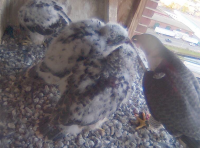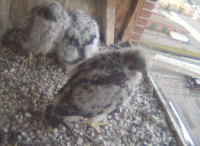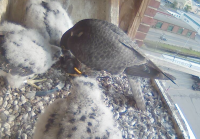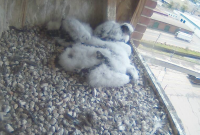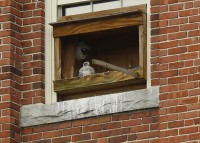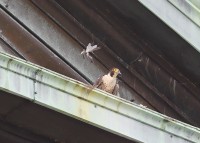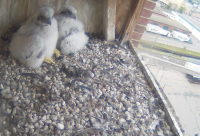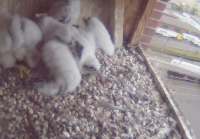Sunday, June 5, 2022. During the 2021 breeding season, the Lawrence Peregrines did not lay eggs in the Ayer Mill Clock Tower nest box. Many individuals and small groups diligently and regularly scanned the skies and mill buildings in the local area, but with no success. During February and March, 2022, the Peregrines were seen many times, but provided absolutely no actionable clues on the whereabouts of their new nest ledge location. We could sense they were nearby, but just didn’t know where.

In March, the male was regularly seen perched on the old smokestack just past the north end of the Casey Bridge and on the west side of the Pacific Mills complex, near the corner of Amesbury and Canal Streets. Most of the time, it was facing the Merrimack River. This image on the left, shows the male lifting off in flight, heading SW, late afternoon on March 16,2022.
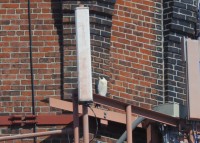 Many mornings, the male was perched in the upper zone of the smokestack, facing south or southeast, and soaking in the morning sun. The departure flight patterns, altitudes, and directions were quite a mix and never really provided firm clues. This image was captured on March 23, 2022, and likely before the female had selected the exact nest ledge location for laying eggs.
Many mornings, the male was perched in the upper zone of the smokestack, facing south or southeast, and soaking in the morning sun. The departure flight patterns, altitudes, and directions were quite a mix and never really provided firm clues. This image was captured on March 23, 2022, and likely before the female had selected the exact nest ledge location for laying eggs.
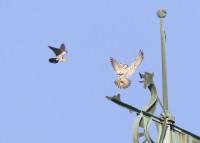
From time to time, the female was seen perched on the faded green weathervane atop the Ayer Mill Clock Tower. This was a fascinating scene to observe as her reaction made it clear that it was not the local male but rather a very unwelcome interloper passing through the neighborhood. She went into full territorial defense mode, rolling over on her back, and using her outstretched talons to send a very clear message! This image was captured on April 5, 2022. At this point the female may have not yet laid eggs. Our biggest challenge was where to look next to find the nest!
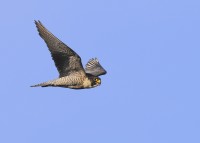
Bridges have played a significant role in the national peregrine falcon recovery, consistently supporting more than 30% of the known population.
In Virginia, two researchers from the Center for Conservation Biology, conducted 166 surveys of bridges in coastal Virginia using a call-broadcast protocol. Broadcast calls were extremely effective in eliciting a response from falcons with nearly 60% and 100% of falcons responding within five and 30 seconds of call initiation respectively.
The ten-minute, call-back protocol includes a series of advertisement and courtship calls interspersed with silent listening periods. Response rates measured from detection trials were 83% during the breeding season overall with a peak of 100% during the courtship period.
Occupied bridges supported more potential nest sites, were longer and higher and were embedded within landscapes with more foraging habitat compared to unoccupied bridges. The current practice of installing nest boxes or trays has resulted in higher breeding success and reproductive output.
The flight image above shows the female responding to one of our call broadcast surveys performed along the east side of the Casey Bridge. After two successful surveys, we had almost full confirmation in regard to the highly probable nest ledge location.
Citation: Watts, B. D. and M. U. Watts. 2017. Investigation of breeding peregrine falcons on bridges. The Center for Conservation Biology. Technical Report Series, CCBTR-17-01. College of William and Mary & Virginia Commonwealth University, Williamsburg, VA. 38 pp.
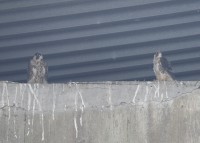
On Sunday afternoon, June 5, 2022, we launched a kayak into the Merrimack River on the upriver and south side of the Casey Bridge. The Joseph W. Casey Bridge runs north/south over the Merrimack River. From the south, access to the bridge is from Parker Street, and from the north, access to the bridge is from Amesbury Street. On kayak approach to one of the large bridge archways, the unseen female started defense cacking vocalizations, and flew off downriver. While scanning the ledges up and under the west side of the bridge, the two peregrine chicks came into view……HOOORAY! Best guess on age is around 34-35 days old, and likely days away from the first one being ready to fledge.
Looking back, and making a number of probability calculations, it looks like the eggs were laid first week in April, hatched first week in May, and the first chick fledged late this past week. These estimates fall within all of the normal breeding season sequence and timing for Peregrine Falcons in Eastern Massachusetts!
Click on any image to enlarge!
 After locating the nest ledge for the Peregrine Falcons last Sunday afternoon from the kayak, was hoping to see if fledglings were out and about in the local area. The view from the kayak strongly suggested they were about 34-35 days old, and days away from fledging, or making first flight from a flat ledge underneath the Casey Bridge.
After locating the nest ledge for the Peregrine Falcons last Sunday afternoon from the kayak, was hoping to see if fledglings were out and about in the local area. The view from the kayak strongly suggested they were about 34-35 days old, and days away from fledging, or making first flight from a flat ledge underneath the Casey Bridge.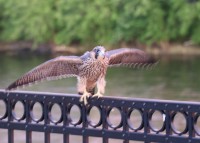 Spotted the vigilant female on one of the old smokestacks, but was totally unable to find any fledglings. After moving to many different vantage points, finally settled in at the Mill240 Park with great elevated views up and down the Merrimack River. A group of loud Crows flushed a smaller raptor from a nearby tree in hot pursuit. The raptor headed upriver, swooped in flight from below me, pulled up, and landed on the black park railing just 15 feet away! The landing and balancing was very awkward. What an unexpected treat!
Spotted the vigilant female on one of the old smokestacks, but was totally unable to find any fledglings. After moving to many different vantage points, finally settled in at the Mill240 Park with great elevated views up and down the Merrimack River. A group of loud Crows flushed a smaller raptor from a nearby tree in hot pursuit. The raptor headed upriver, swooped in flight from below me, pulled up, and landed on the black park railing just 15 feet away! The landing and balancing was very awkward. What an unexpected treat!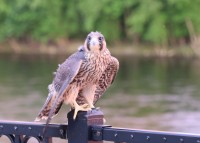 Turns out to be one of the 2022 fledglings!! While out scanning with just binoculars, had to quickly run back to the car and grab a camera. This was about 13 minutes after sunset with clouds on the western horizon dimming the light as dusk settled in. While trying to get the right camera settings, a group of 4 youngsters crept a bit closer from the park, and initially tried to startle the bird. After gently encouraging them to quiet down a bit, they were very curious to know what type of bird it was, how old it was, and where it had nested….a great teaching moment out in the field!
Turns out to be one of the 2022 fledglings!! While out scanning with just binoculars, had to quickly run back to the car and grab a camera. This was about 13 minutes after sunset with clouds on the western horizon dimming the light as dusk settled in. While trying to get the right camera settings, a group of 4 youngsters crept a bit closer from the park, and initially tried to startle the bird. After gently encouraging them to quiet down a bit, they were very curious to know what type of bird it was, how old it was, and where it had nested….a great teaching moment out in the field!
 Many mornings, the male was perched in the upper zone of the smokestack, facing south or southeast, and soaking in the morning sun. The departure flight patterns, altitudes, and directions were quite a mix and never really provided firm clues. This image was captured on March 23, 2022, and likely before the female had selected the exact nest ledge location for laying eggs.
Many mornings, the male was perched in the upper zone of the smokestack, facing south or southeast, and soaking in the morning sun. The departure flight patterns, altitudes, and directions were quite a mix and never really provided firm clues. This image was captured on March 23, 2022, and likely before the female had selected the exact nest ledge location for laying eggs.

